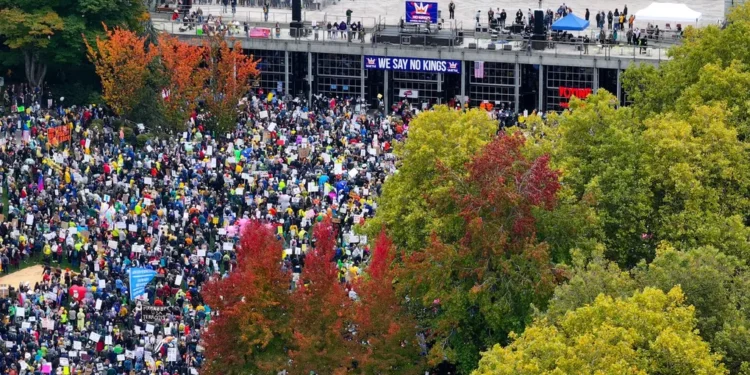Another round of “No Kings” protests took place Saturday with gatherings across Washington and nationwide.
The coalition that organized the Seattle Hands Off and Seattle No Kings march in June organized a rally and march Saturday at Seattle Center. The group marched peacefully through downtown Seattle from noon to 4 p.m. as organizers planned.
People began arriving at Seattle Center at 11 a.m. to gather for the rally. Seattle police advised there would be traffic impacts throughout the city. The march began at Seattle Center at 12:30 p.m. and entered downtown Seattle.
By 2:50 p.m., Seattle police reported the protest was a mile long. By 3 p.m., Seattle police reported the group had peacefully dispersed after arriving on 1st Avenue and Pike Street.
At least 70,000 demonstrators gathered for the protest in June, turning the city into a sea of voices calling for change. The initial round of protests happened on President Donald Trump’s birthday.
Previously, protesters have called for Trump to be “dethroned” as they compare his actions to those of a king and not a democratically elected president.
“President Trump wants to be a dictator,” organizers said. “But Americans bow to No Kings: He’s using orders, intimidation, and the full force of the federal government to crush dissent, seeking to control what schools teach, what news and voices we hear, and weaponizing the Department of Justice against his critics.”
Thousands of protesters attended the Seattle march Saturday morning, as well as smaller rallies in various neighborhoods and cities across western Washington.
Organizers in Seattle marched from the Seattle Ferry Terminal to Seattle Center beginning at 11 a.m. and then linked up with the main protest.
The peaceful nature of the demonstration reflected organizers’ emphasis on lawful protest and avoiding confrontations that could undermine the movement’s messaging. Seattle’s history of large-scale protests, from WTO demonstrations in 1999 to Black Lives Matter rallies in 2020, means law enforcement and protest organizers have established protocols for managing mass gatherings.
The mile-long protest line represents significant turnout, though smaller than June’s estimated 70,000 participants. Second and subsequent rallies in ongoing protest movements typically see reduced attendance as initial momentum wanes and participants experience “protest fatigue.”
The coordinated timing of protests across Washington and nationwide demonstrates the organizational capacity of anti-Trump coalitions to mobilize supporters simultaneously in multiple locations, amplifying media coverage and political impact.
Seattle Center’s selection as a rally point provides large open space for gatherings while the march route through downtown maximizes visibility and symbolic significance by traversing the city’s commercial and governmental core.







